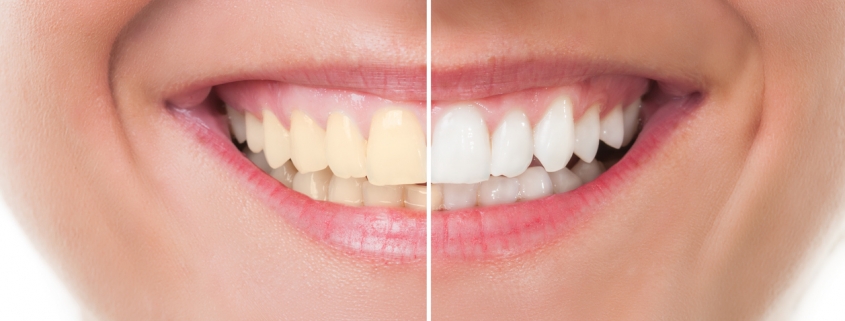Teeth Whitening 101
It doesn’t take much these days to get surface stains on your teeth. Coffee and wine drinkers and those who frequently use tobacco products are most susceptible to developing yellow or grey-toned teeth, but age also plays a role with our teeth naturally darkening the older that we get. However, with the media at our front and center every day, no one wants their teeth to look like this, even though teeth are not naturally meant to be completely white. As a result, procedures–both at home and in the dentist chair–have become widely available for those who seek it out. The treatment is considered cosmetic, and therefore not covered under insurance should you seek professional treatment, and comes in two forms: surface whiteners and dental bleaches.
Teeth Surface Whiteners
Definitely the more affordable out of the two, these teeth whiteners can be found at any local grocery store or pharmacy, nestled among the many brands of toothpaste and mouthwash. Each company will have its own version of a ‘whitening strip’, but they all essentially work the same way. Likewise, each brand will also have their own whitening toothpaste that is like regular toothpaste, but will generally have some sort of course material within to scrub and polish the surface of the tooth to remove the stains. These products are safe to use and are very unlikely to cause any wear and tear on the tooth itself. Keep in mind that products under this category of ‘surface whiteners’ are designed for just that: surface stains. These products will not correct heavy staining or internal staining, and definitely should not be used in place of a professional cleaning done by your dentist.
Dental Bleaches
Bleach treatments are best done from the comforts of the dentist’s office, but are much more expensive and may not achieve the desired outcome. A consultation with your dentist will determine whether this teeth whitening treatment is best for you, depending on the circumstances in which your tooth has become discolored. This is vitally important to ask of those who have undergone procedures such as filling, crowns, and root canal treatments since this type of discoloration is not the same as coffee stains. Once cleared for the procedure, there are two different kinds of bleach treatments available for teeth whitening, both of which your dentist will go over with you in explicit detail.
- Vital bleaching is done on teeth that are considered “alive” and is generally used for removing stains caused by coffee and wine, as well as teeth that have grown naturally dark with age.
- Non-vital bleaching is done on teeth that are not considered “alive”, such as teeth that have had their color altered by treatments like a root canal or a filling. Non-vital bleaching works within the tooth and whitens it from the inside out.
Once the treatment has been selected, it now comes down to choosing the method. This is determined by the number of teeth that the client wishes to be whitened, as well as the history on the tooth and how it came to be discolored.
- The first method involves using a combination of light and heat on the teeth that have a special bleach applied to them. This often yields the fastest results as the light and heat activate the bleaching process right away.
- The second method involves wearing a mouthguard custom fit to your mouth. The mouthguard is filled with the same bleach and you will be instructed to wear it for a certain amount of time during parts of your day.
- The final method involves using a special toothpaste (not drugstore brand) that is mixed with the same special bleach.
Once again, only your dentist can make the call on which treatment and method is safe and effective for you to use. If you believe that teeth whitening is something that you would like to pursue, please contact your dentist for a free consultation and look over your options.

